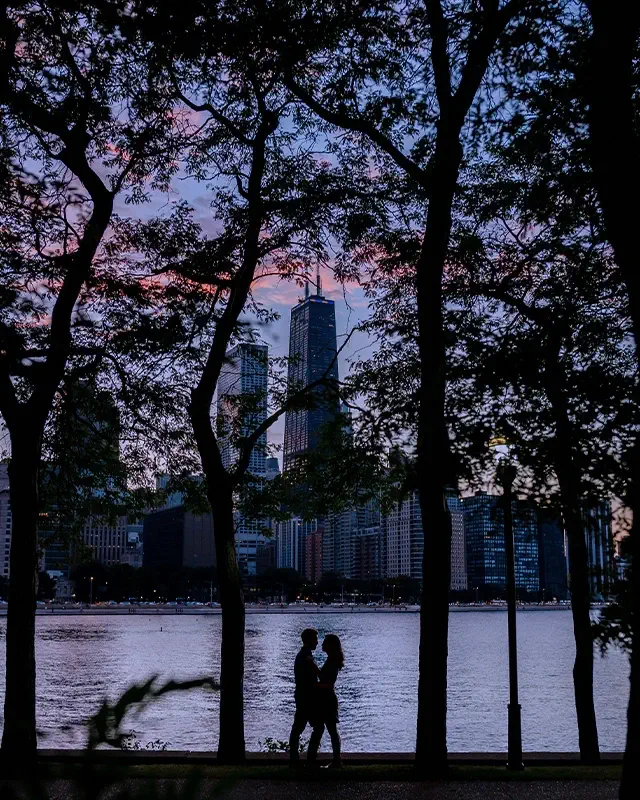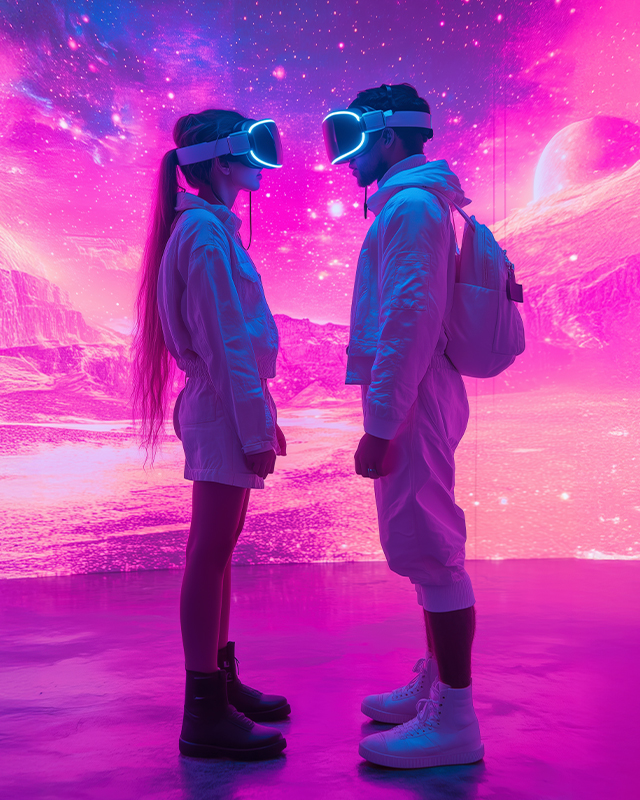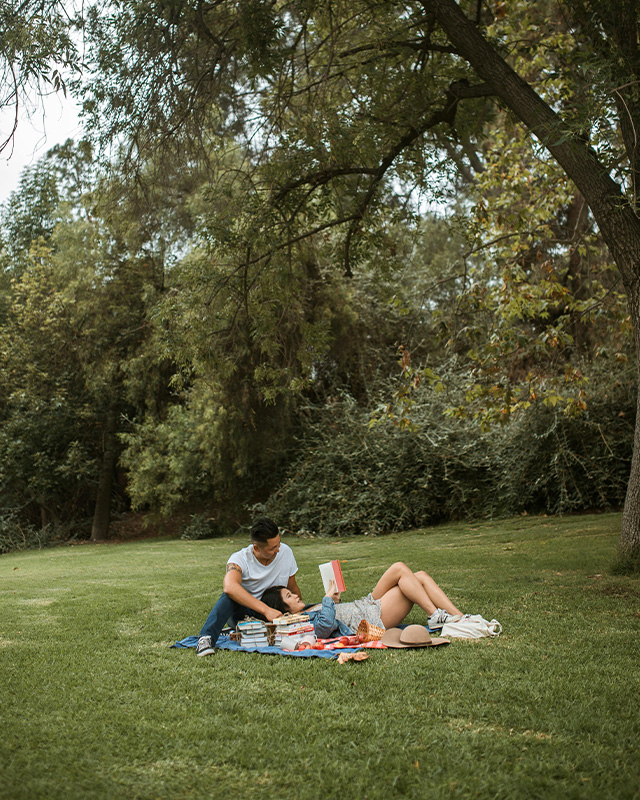In the heart of the Midwest, where the skyline reaches the heavens, and the streets buzz with anecdotes, Chicago stands as a testament to resilience, innovation, and cultural confluence. For those seeking an exceptional first date that transcends the ordinary and delves into history, a guided walking tour through the Windy City’s storied past offers an engaging and educational way to spend time together. This hour-long journey, best undertaken in the soft, amber glow of early evening, is a captivating exploration of Chicago’s hidden gems.
Starting Point
Chicago Water Tower – 806 North Michigan Avenue
The Chicago Water Tower is an enduring symbol of Chicago’s resilience and architectural heritage. Built in 1869, this Gothic Revival structure is one of the few buildings that survived the devastating Great Chicago Fire of 1871, earning it a special place in the city’s history and the hearts of its residents.
Designed by architect William W. Boyington, the Water Tower was constructed using distinctive yellowing Lemont limestone. Its castle-like appearance, complete with turrets and crenellations, gives it a fairy-tale quality, making it an iconic landmark along Chicago’s Magnificent Mile. Standing 182.5 feet tall, the tower originally housed a 138-foot high standpipe used to regulate water pressure for firefighting and control water surges in the area.
The tower’s survival of the Great Chicago Fire of 1871 was nothing short of miraculous. As flames engulfed the city, destroying most structures in their path, the Water Tower remained standing, becoming a beacon of hope for the city’s residents. In the aftermath of the fire, it served as a rallying point for the city’s rebuilding efforts, symbolizing Chicago’s famous “I Will” spirit.
Today, the Chicago Water Tower continues to captivate visitors and locals alike. It has been repurposed as the City Gallery, showcasing works by local artists and photographers. The tower’s historical significance extends beyond its architectural beauty; it represents Chicago’s ability to rise from the ashes and rebuild itself into a thriving metropolis. As one of the oldest water towers in the United States, it is a testament to the city’s innovative approach to urban planning and infrastructure in the 19th century.
Stop 2
John Hancock Center – 875 North Michigan Avenue
A short stroll down Michigan Avenue brings you to the John Hancock Center, now officially known as 875 North Michigan Avenue. This towering skyscraper, completed in 1969, is an engineering marvel and a testament to Chicago’s architectural prowess. At 1,128 feet, it offers breathtaking views of the city and Lake Michigan.
While you won’t ascend to the observation deck on this tour, the building provides ample fodder for conversation. It’s an excellent opportunity to marvel at the innovative design by Peruvian-American chief designer Bruce Graham and Bangladeshi-American structural engineer Fazlur Rahman Khan of Skidmore, Owings and Merrill (SOM), who introduced the concept of the “trussed tube” structural system. This innovation allowed for greater height and stability, paving the way for constructing supertall skyscrapers worldwide. The John Hancock Center’s sleek, black exterior and distinctive X-bracing make it a standout in Chicago’s skyline.
Stop 3
Fourth Presbyterian Church – 126 East Chestnut Street
Continue walking to the Fourth Presbyterian Church. This stunning Gothic Revival church, completed in 1914, offers a serene contrast to the bustling city streets. Its intricate stonework, soaring spires, and tranquil courtyard provide a peaceful respite and a glimpse into the spiritual life of early 20th-century Chicagoans.
As you explore the church’s exterior, share the story of its founding and its role in the community. The Fourth Presbyterian Church has long been a center for social justice and outreach, reflecting the progressive spirit of its congregation. It’s a perfect spot to pause and reflect on the importance of such institutions in fostering community and providing support during times of need.
Stop 4
Newberry Library, 60 West Walton Street
The Newberry Library is a renowned independent research institution with a rich history and an invaluable collection of rare books, manuscripts, and maps. Founded in 1887 through the generous bequest of Walter L. Newberry, a prominent Chicago businessman and philanthropist, the library has since become a cornerstone of scholarly research and cultural preservation.
The library’s Renaissance Revival building, designed by Henry Ives Cobb, opened its doors in 1893. Its grand entrance, adorned with stately columns, reflects the scholarly elegance and importance of the institution. The pink granite exterior, sourced from Branford, Connecticut, gives the building a distinctive appearance that has become an iconic part of Chicago’s architectural landscape.
The Newberry’s collections are vast and diverse, spanning more than six centuries of human history. With over 1.5 million books, 5 million manuscript pages, and 500,000 historical maps, the library offers an unparalleled resource for researchers and scholars.
In its early years, the Newberry acquired several significant collections, including the music library of Count Pio Resse and the linguistic materials of Louis-Lucien Bonaparte. A pivotal moment came in 1896 when the library agreed with the Chicago Public Library and the John Crerar Library, focusing its collection on the humanities.
While primarily a research institution, the Newberry is committed to public engagement. It regularly hosts exhibitions, seminars, lectures, and performances, making its resources accessible to a broader audience. The library’s commitment to fostering learning is evident in its mission statement, emphasizes inspiring research and encouraging conversations about ideas that matter to diverse audiences.
The Newberry continues to grow and adapt to the changing landscape of research and scholarship. Its strategic plan focuses on advancing knowledge, building diverse learning communities, increasing access to its collections, and strengthening institutional health. Recent acquisitions, such as the maps and archives from Rand McNally & Company, demonstrate the library’s ongoing commitment to expanding its resources.
Stop 5
Washington Square Park – 901 North Clark Street
Adjacent to the Newberry Library is Washington Square Park, also known as Bughouse Square. Established in 1842, this historic park has long been a gathering place for free speech and public debate. In the early 20th century, it was a hub for soapbox orators, labor activists, and social reformers.
From the 1910s through the mid-1960s, Bughouse Square came alive during warm evenings as orators, known as “soapboxers,” took to improvised platforms to address gathered crowds. The park reached its peak of activity and influence during the 1920s and 1930s, attracting diverse speakers. Poets and artists shared the space with religious preachers, political activists (particularly from revolutionary left organizations), and eccentric personalities with self-proclaimed visions.
Several soapboxers achieved legendary status for their regular appearances and captivating speeches. Lucy Parsons, a prominent anarchist, was known for her fiery rhetoric, while Ben Reitman, dubbed the “clap doctor,” drew crowds with his unconventional views. John Loughman, a veteran of labor wars, and Frank Midney, a socialist orator, represented the strong presence of labor activists in the square.
The park also saw its share of colorful characters. Martha Biegler made her mark as a feminist-Marxist speaker, while Frederick Wilkesbarr, who went by “The Sirfessor,” and Herbert Shaw, nicknamed the “Cosmic Kid,” became local celebrities. The Sheridan twins, Jack and Jimmy, were known for their dynamic duo performances, and “Cholly” Wendorf, a one-armed speaker, captivated audiences with his unique presence.
Although the original era of Bughouse Square’s soapboxing culture faded by the mid-1960s, its spirit lives on. A dedicated Bughouse Square Committee, based at the Newberry Library, organizes annual free-speech gatherings in the park. These events, held each July in conjunction with the library’s yearly book sale, serve as a reminder of the park’s rich history and the enduring importance of public discourse in American society. Through these modern gatherings, the legacy of Bughouse Square as a bastion of free speech and lively debate continues to inspire new generations of Chicagoans and visitors alike.
Stop 6
Driehaus Museum – 40 East Erie Street
The Richard H. Driehaus Museum is a remarkable institution that offers visitors a glimpse into the opulence of America’s Gilded Age. Housed in the meticulously restored Nickerson Mansion, the museum showcases art, architecture, and design from the late 19th and early 20th centuries.
Built in 1883, the mansion earned the nickname “Marble Palace” due to its extensive use of 17 different types of marble throughout the structure. The building’s survival is a testament to Chicago’s preservation efforts, having been saved twice – first by a collective of over 100 Chicago citizens in 1919 and later by philanthropist Richard H. Driehaus, who sponsored its restoration from 2003 to 2008.
The museum’s collection reflects the vision and interests of its founder, Richard H. Driehaus. It features a diverse array of European and American artifacts created predominantly between 1880 and 1920, including stunning examples of period furniture, decorative arts, stained glass, and works by Louis Comfort Tiffany. The Driehaus Collection of Fine and Decorative Arts supplements the original works of the mansion’s architects and interior designers, providing visitors with an immersive experience of Gilded Age luxury.
Beyond its permanent collection, the Driehaus Museum offers temporary exhibitions, guided tours, and various public programs. These include concerts, lectures, and family-oriented events that align with the museum’s mission to promote architectural preservation, decorative arts, and Gilded Age culture. The museum’s recent expansion to include the 1926 Murphy Auditorium has further enhanced its ability to engage with the public and host diverse programming.
The Driehaus Museum stands as a cultural gem in Chicago, offering visitors a unique opportunity to step back in time and experience the grandeur of the Gilded Age. Its commitment to preservation, education, and artistic excellence makes it an invaluable resource for those interested in American design and architecture history.
Stop 7
Tribune Tower – 435 North Michigan Avenue
The Tribune Tower is an iconic neo-Gothic skyscraper that has been a prominent feature of the city’s skyline since its completion in 1925. Standing 462 feet tall with 36 floors, the tower is renowned for its architectural beauty and the unique story behind its creation.
In 1922, the Chicago Tribune held an international design competition to create “the most beautiful office building in the world” to serve as its new headquarters. This competition, which offered a substantial prize of $50,000 to the winner, attracted over 260 entries from 23 countries and became a historic event in 20th-century architecture. The winning design, submitted by New York architects John Mead Howells and Raymond Hood, featured a neo-Gothic style that blended modern structural engineering with historical architectural elements.
One of the most fascinating aspects of the Tribune Tower is its exterior decoration. Embedded in the limestone walls at the base of the building are nearly 150 fragments from famous structures and historic sites from around the world. These include pieces from the Taj Mahal, the Parthenon, the Great Wall of China, and even a moon rock. These fragments were collected by Chicago Tribune correspondents in the late 19th and early 20th centuries, reflecting the newspaper’s global reach and ambition.
The tower’s design incorporates numerous Gothic elements, including flying buttresses at its crown, which are particularly striking when illuminated at night. The building’s ornate facade also features intricate stone carvings, including depictions of Robin Hood and a howling dog near the main entrance, playful references to the architects’ names—Hood and Howells.
While the Tribune Tower was initially built as the headquarters for the Chicago Tribune newspaper, it has recently undergone a significant transformation. 2018, the building was converted into a luxury condominium, marking a new chapter in its storied history. Despite this use change, great care was taken to preserve the building’s historic character and architectural significance. The conversion project won a Driehaus Prize for architectural preservation and adaptive reuse from Landmarks Illinois in 2023, highlighting the successful balance between modernization and historic preservation.
Today, the Tribune Tower is a testament to Chicago’s architectural heritage and the enduring power of innovative design. It continues to captivate visitors and residents alike, reminding them of the city’s rich cultural and journalistic history while adapting to the changing urban landscape of the 21st century.
Stop 8
Chicago Riverwalk – 435 North Michigan Avenue
Conclude your tour with a stroll along the Chicago Riverwalk. This vibrant, 1.25-mile-long promenade stretches along the south bank of the Chicago River’s Main Branch, offering a unique urban oasis in the heart of the city. Completed in 2016, this linear park has transformed a once-neglected industrial waterfront into a thriving public space that seamlessly blends recreation, commerce, and natural beauty.
The Riverwalk is divided into six distinct “rooms,” each with its character and purpose. These include the Marina Plaza, which offers dining options and boat docking; the Cove, designed for kayaking and other water activities; the River Theater, featuring a grand staircase connecting Upper Wacker Drive to the river; the Water Plaza, with its interactive fountain; the Jetty, showcasing floating gardens and opportunities for fishing; and the Confluence, where the river’s branches meet.
Since its completion, the Chicago Riverwalk has become a significant economic driver for the city. It has created hundreds of new jobs, doubled the number of vendors along the river, and significantly increased profits for businesses in the area. The project has also catalyzed over $12 million in funding for the redevelopment of earlier phases of the Riverwalk, demonstrating its success in urban renewal and economic development.
Beyond its economic impact, the Riverwalk has dramatically enhanced the ecological health of the Chicago River. The project incorporates extensive plantings, including 66 species of plants and trees, which help improve water quality and provide habitat for local wildlife. The Riverwalk’s design also addresses flood resilience, with features that can quickly recover following inundation, showcasing innovative approaches to urban environmental challenges.
The Chicago Riverwalk is a testament to the city’s commitment to creating accessible, multi-functional public spaces. It has revitalized the riverfront and provided a new perspective on urban living, offering residents and visitors alike a place to connect with nature, engage in recreational activities, and enjoy the unique beauty of Chicago’s architectural landscape. As a model of successful urban renewal, the Riverwalk continues to inspire similar projects in cities worldwide, demonstrating the transformative power of thoughtful public space design.

Why a Historical Walking Tour?
A walking tour allows for a more dynamic and interactive experience. Unlike a static dinner or movie date, you’re constantly on the move, discovering new sights and learning together. This shared journey fosters a sense of camaraderie and adventure, laying the groundwork for a deeper connection.
A walking tour of a city such as Chicago offers a unique and immersive way to explore its rich history, architecture, and culture. On foot, we can get close to iconic buildings and landmarks, discover hidden architectural details, and experience the vibrant street life and atmosphere.
One of the unique advantages of a self-guided walking tours is that it is an efficient way to explore a city. A well-planned tour allows you to cover much ground efficiently, see key sights without getting lost and discover places you might miss alone. Guides plan routes that ensure “you don’t miss the main sights and still have time to learn about the city secrets only the locals know.” Feel free to abandon this walking tour if you see something along the way that intrigues you.
A walking tour is a social experience, offering opportunities to discuss the city and share experiences. Many find walking tours “a great way to meet people” while exploring. By combining exercise, education, and exploration in a social setting while on a date, a walking tour offer a uniquely rewarding way to experience all that Chicago has to offer.
Some Practical Tips
Begin your exploration about an hour before sunset to take advantage of the golden hour’s enchanting light, which bathes Chicago’s landmarks in a warm, romantic glow. The one-hour tour concludes perfectly with a picturesque sunset walk along the Riverwalk.
Choose comfortable footwear and layer your clothing to accommodate Chicago’s changeable weather. A lightweight jacket or sweater is recommended, particularly if you intend to extend your evening with a Riverwalk stroll.
While this self-guided tour is designed for independent exploration, consider enriching your experience with historical podcasts or audio guides. The Chicago History Museum’s website offers many resources that can provide valuable context and insights about the city’s past and architecture. As you walk through its streets, these additional materials can deepen your understanding and appreciation of Chicago’s rich history.
The Historical Walking Tour of Chicago offers a refreshing alternative to first dates that can feel like rehearsed performances. It’s an opportunity to step outside the confines of conventional dating and embark on a journey of discovery, both of the city and each other. So lace up your walking shoes, grab a map—or app—and prepare to be captivated by the stories that have shaped Chicago – and perhaps, in the process, write a new chapter of your own.







